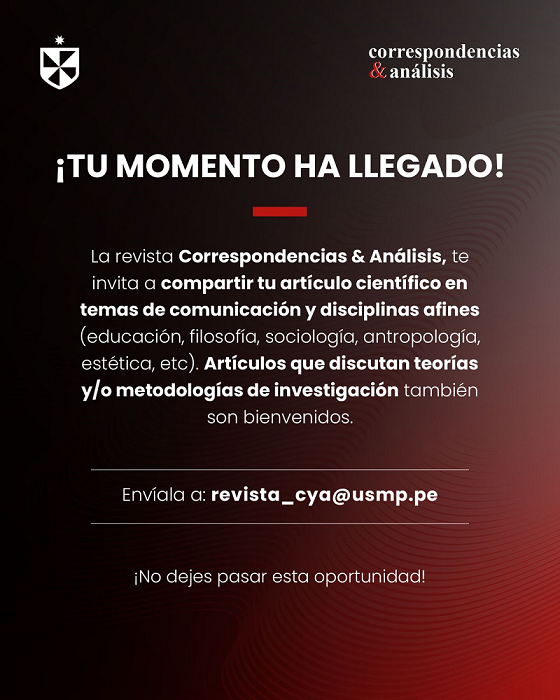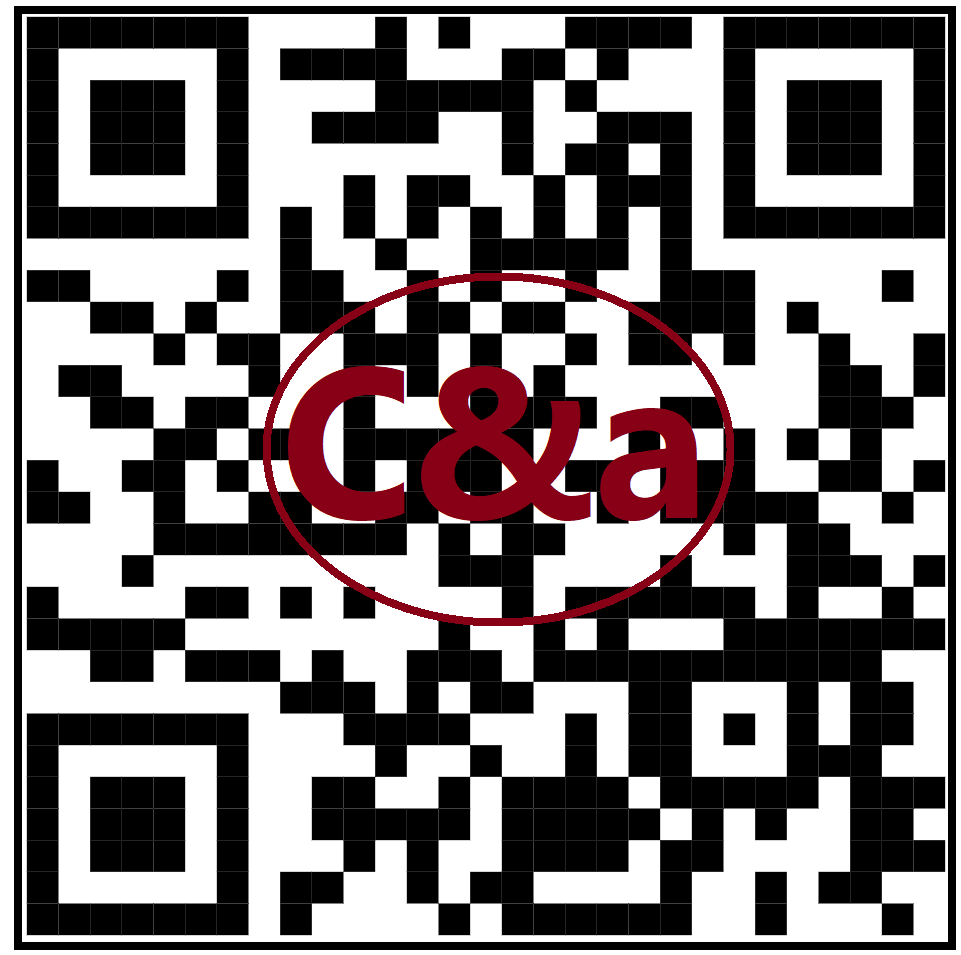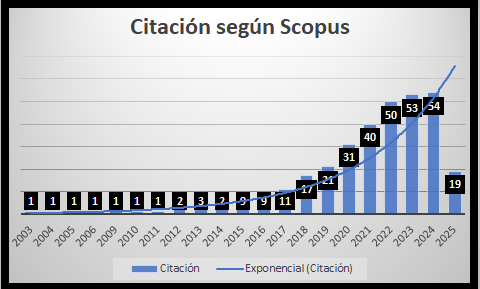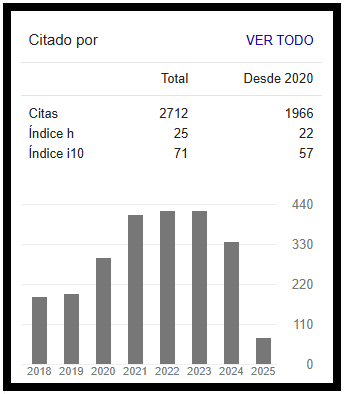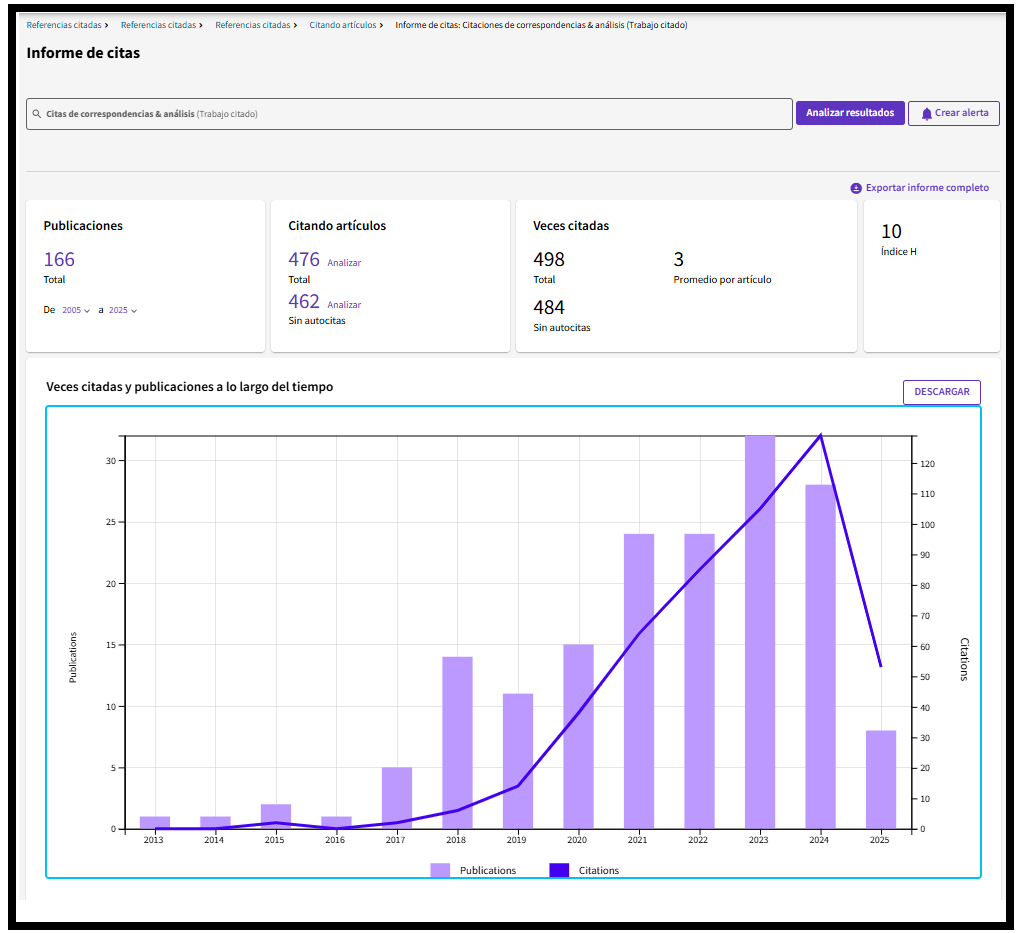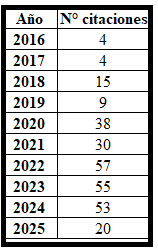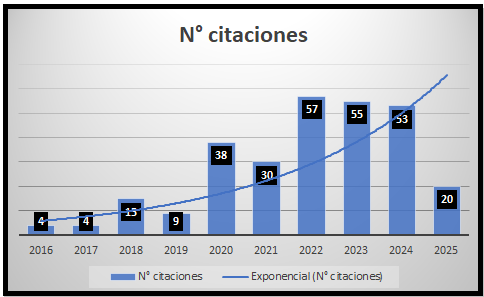The visual essay: rethingking communications from Hybridity
DOI:
https://doi.org/10.24265/cian.2018.n8.08Keywords:
Visual Essay, Photo Essay, Visual Culture, Practice-Led research, Multisensorial Communication, Hybrid Research, Visual Thinking, Aesthetics and CommunicationAbstract
This article reflects on visual essay as a research instrument within social communication, which builds meaning from the visual, linking ideas, emotions and affects, and contributes to build an inclusive public sphere at the service of the public good, within visual culture. Its hybrid nature intertwines visual and verbal language, which, unlike other visual and audiovisual products, allows argumentation and to build a thought that includes subjectivity, but also to the Other. It is from this relationship with the Other that proposes a way of learning and interacting with reality as something different, according to sensitivities that aestheticization of social communication demands, and obtains its truth from the intersubjectivity with which it is constructed.
Metrics
Downloads
References
Abril, G. (2010). Cultura visual y espacio público-político. Cuadernos de Información y Comunicación, 15, pp. 21-36. Recuperado de http://dialnet.unirioja.es/servlet/ejemplar?codigo=252834
Avendaño, N. (2017). Las competencias investigativas en las ciencias de la comunicación: percepción de profesores universitarios. Revista Cultura de Guatemala, 38(1), 111-124. Recuperado de http://ezproxybib.pucp.-edu.pe:2048/login?url=-http://search.ebscohost.com/login.-aspx?direct=true&db=a9h&AN=124791333&lang=es&site=eds-live&scope=site
Barrios, H. (2015). Subjetividades en el ágora digital: cuestiones para la educación y la bioética. Revista Latinoamericana de Bioética, 15(2), 84-95. Recuperado de http://eds.b.ebscohost.com.ezproxybib.pucp.edu.-pe:2048/eds/pdfviewer/pdfviewe
Barrett, E. & Bolt, B. (Eds.). (2007). Practice as research. Approaches to creativity arts inquiry. Londres: I. B. Tauris.
Baudrillard, J. (2002). Contraseñas. Barcelona: Anagrama.
Bauman, Z. (2000). La modernidad líquida. México, DF: Fondo de Cultura Económica. Recuperado de http://www.oei.org.ar/edumedia/pdfs/T14_-Docu1_Lamodernidadliquida_Bauman.pdf
Behling, O & Starke, F (1973). The Postulates of Expectancy Theory. The Academy of Management Journal, 16(3), 373-388.
Berger, J. (2007). Modos de ver. Barcelona: Gustavo Gili.
Bolt, B. (2004). Art beyond representation. The performative power of the image. Recuperado de https://www.academia.edu/93932/Art_beyond_-representation_the_performative_power_of_the_image
Borgdorff, H. (2017). O conflito das faculdades: sobre teoria, prática e pesquisa em academias profissionais de artes. Opus, 23(1), 314-323. Recuperado de https://anppom.com.br/revista/index.php/opus/article/view-/420/418
Brea, J. (2005). Los estudios visuales. Por una epistemología política de la visualidad. En J. Brea (Ed.), Estudios visuales: la epistemología de la visualidad en la era de la globalización (pp. 5-16). Madrid: Akal.
Cáceres Calderón, C. (2006). Viabilidad de una emisora de tv local, en tiempos de globalización. El caso de la ciudad de Arequipa (tesis de maestría). Pontificia Universidad Católica del Perú. Recuperado de http://tesis.pucp.edu.pe/repositorio/bitstream/handle/12345678/78/CACERES_CALDERON_ZAIDA_-VIABILIDAD_DE_EMISORA.pdf
Candy, L. (2006). Practice Based Research: A Guide. Recuperado de https://www.creativityandcognition.com/resources/PBR%20Guide-1.1-2006.pdf
Carrillo, P. (2015). La investigación basada en la práctica de las artes y los medios audiovisuales. Revista Mexicana de Investigación Educativa, 20(64), 219-240 Recuperado de http://ezproxybib.pucp.edu.pe:2048/login?url=http://search.ebscohost.com/login.aspx?direct=true&db=eue&AN=1009
Carter, P. (2007). Interest: The ethics of invention. En E. Barrett & B. Bolt (Eds.), Practice as research. Approaches to creativity arts inquiry. Londres: I. B. Tauris.
Da Silva, G. (2002). Ecosistema educativo. Recuperado de http://www.riial.org/espacios/educom/educom_prop1tall6.pdf
Del Valle, J. (2011). La dignidad de la imaginación. Alexander Baumgarten y el contexto del nacimiento de la estética. Areté. Revista de Filosofía. 23(2), 303-328.
Evans, J. & Hall, S. (2004). What is visual culture? En J. Evans & S. Hall (Eds.), Visual Culture: the reader (pp. 1-7). Londres: SAGE.
Fiske, J., Anzola, P. & Ravassa, G. (1984). Introducción al estudio de la comunicación. Bogotá: Norma.
Friedman, A. (2014). The relationship between research method and visual display: a study of conference proceedings in the field of knowledge organization. Information Research, 19(4). Recuperado de http://eds.b.ebscohost.com.ezproxybib.pucp.edu.pe:2048/eds/detail/detail?vid=11sid=1ad31020494d480a967ba48ee00b6c7e%40session-mgr4007&bdata=Jmxhbmc9ZXMmc2l0ZT1lZHMtbGl2ZSZzY29wZT1za-XRl#AN=100304902&db=lih
García Gil, M. (2011). El vídeo como una herramienta de investigación. Una propuesta metodológica para la formación de profesionales en Comunicación. Revista del CES Felipe II, 13. Recuperado de http://www.ces-felipesegundo.com/revista/articulos2011/Monica%20Garcia.pdf
Gómez, C. (2000). Revolución tecnológica: un nuevo paradigma para la comunicación. Signo y Pensamiento, 36(XIX), 11-18 Recuperado de http://revistas.javeriana.edu.co/index.php/signoypensamiento/article/view/2978
Hernani, V. (2018). En modo incógnito: un estudio exploratorio sobre la representación del cuerpo femenino en la pornografía en internet. Lima: Pontificia Universidad Católica del Perú.
Huber, L. (2002). Consumo, cultura e identidad en el mundo globalizado. Estudios de caso en los Andes. Lima: Instituto de Estudios Peruanos.
Lipovetsky, G. & Serroy, J. (2015). La estetización del mundo. Barcelona: Anagrama.
Karatzogianni, A. (2012). Epilogue: The Politics of the Affective Digital. En A. Karatzogianni & A. Kuntsman (2012), Digital Cultures and the Politics of Emotion. Feelings, Affect and Technological Change (pp. 245-249). Londres: Palgrave Macmillan.
Machado, A. (2010). El filme-ensayo. La Fuga, 11, 1-9. Recuperado de http://lafuga.cl/el-filme-ensayo/409
Marquina, O. (2011). Los aportes al currículo desde las artes visuales, entendidas como una manifestación de la cultura visual actual (tesis de maestría). Pontificia Universidad Católica del Perú. Recuperado de http://tesis.pucp.edu.pe/repositorio/handle/123456789/1435
Marquina, O. (2016). La cultura visual desde el campo social de la mirada. Revista Conexión, 5(5), 88-101. Recuperado de http://revistas.pucp.edu.pe/index.php/conexion/article/download/14990/15521
McLuhan, M. (1972). La Galaxia de Gutenberg. Génesis del “homo typographicus”. Madrid: Aguilar.
McNiff, S. (1998). Art-based research. Londres: Jessica Kingsley Publishers. Recuperado de https://books.google.com.pe/books?id=PwLrBQAAQBAJ&printsec=frontcover&hl=es&source=gbs_ge_summary_r&cad=0#v=onepage-&q&f=false
Mirzoeff, N. (2003). Introducción: ¿Qué es la cultura visual? En N. Mirzoeff (Ed.), Una introducción a la cultura visual (pp. 17-61). Barcelona: Paidós.
Mirzoeff, N. (2004). The subject of visual culture. En N. Mirzoeff (Ed.), Visual Culture Reader (pp. 3-23). Londres: Routledge Taylor & Francis Group.
Mitchell, W. (2003). Mostrando el ver: una crítica de la cultura visual. Recuperado de http://www.estudios-visuales.net/revista/pdf/num1/mitchell.pdf
Mitchell, W. (2009). Teoría de la imagen. Madrid: Akal.
Núñez Murillo, G. (2015). Culturas orales y culturas escritas. Lima: PUCP.
Pauwels, L. (1993). The visual essay: Affinities and divergences between the social scientific and the social documentary modes. Visual Anthropology, 6(2), 199-210. doi:10.1080/08949468.1993.9966615
Pauwels, L. (2012). Conceptualizing the Visual Essay as a Way of Generating and Imparting Sociological Insight: Issues, Formats and Realizations. Sociological Research Online, 17 (1). Recuperado de http://www.socresonline.org.uk/17/1/1.html
Pesci, E. (2007). Vídeo-Ensayo, narrativa maestra del pensamiento audiovisual. Recuperado de http://fido.palermo.edu/servicios_dyc/encuentro2007/02_auspicios_publicaciones/actas_diseno/articulos_-pdf/A6036.pdf
Pink, S. (2001). Doing Visual Anthropology. Londres: Sage Publications.
Pombo, V. (2011). La globalización digitalizada. Nómadas. Revista Crítica de Ciencias Sociales y Jurídicas, 31(3), 1-6. Recuperado de https://revistas.ucm.es/index.php/NOMA/article/viewFile/36830/35651
Ramírez, M. & Marquina, O. (2016). Comunicación y diseño en la prensa impresa. Lima: PUCP.
Roel, V. (1998). La tercera revolución industrial y la era del conocimiento. Lima: Fondo editorial UNMSM.
Romeu, V. (2018). Reflexiones profanas en torno al arte como fenómeno comunicativo. México, DF: Editorial Nómda.
Roque, A. (19 de febrero de 2017). Verdad, veracidad y verosimilitud. PULSO, Diario de San Luis. Recuperado de http://pulsoslp.com.mx/opinion/verdad-veracidadverosimilitud/
Rossi, D. (2007). Los ciudadanos interpelados por nuevos sistemas y prácticas de comunicación: actualizando la agenda de políticas democratizadoras. Recuperado de https://nanopdf.com/download/losciudadanos-interpelados_pdf
Saad, A. & De la Hoz, J. (2016). La enseñanza del nuevo discurso periodístico en instituciones de educación superior. Encuentros, 14(2). doi:10.15665/re.v14i2.775
Santos, M. (1998). Imagen y educación. Buenos Aires: Editorial Magisterio del Río de la Plata.
Salvat, G. & Serrano, V. (2011). La revolución digital y la sociedad de la información. Sevilla: Comunicación social ediciones y publicaciones. Recuperado de https://books.google.com.pe/books?id=EqkmWOV5QbAC&pg=PA13&source=gbs_toc_r&cad=3#v=onepage&q&f=false
Sartori, G. (1998). Homo Videns. La sociedad teledirigida. Madrid: Taurus.
Schroeder, J. (2003). Visual Methodologies and Analysis. Visual Anthropology, 16(1), 81-88. doi: 10.1080/08949460309595101
Simone, R. (2001). La tercera fase. Formas de saber que estamos perdiendo. Madrid: Taurus.
Sinclair, J. (2009). Televisión. Comunicación global y regionalización. Barcelona: Gedisa.
Sturken, M. & Cartwright, L. (2003). Practices of Looking. An Introduction to Visual Culture. Nueva York: Oxford University Press.
Toffler, A. (1980). La tercera ola. Bogotá: Plaza & Janés. Recuperado de http://cruceshernandezguerra.wikis-paces.com/file/view/La+tercera+-ola.pdf
Vásquez, A. (2011). El ensayo fotográfico, otra forma de narrar. Quórum académico, 8(16),301-314. Recuperado de https://dialnet.unirioja.es/descarga/articulo/3865249.pdf
Villanueva, E. (2015). Medios digitales: conceptualizando la innovación tecnológica en comunicación social. Lima: PUCP.
Yezers’ka, L. & De Pozo, R. (2017). Integración de la cultura digital en la formación de comunicadores en Perú. Comhumanitas: Revista Científica de Comunicación, 8(1), 61-80 Recuperado de http://ezproxybib.pucp.edu.-pe:2048/login?url=http://search.ebscohost.com/login.aspx?direct=true&db=a9h&AN=129786606&lang=es&site=eds-live&scope=site
Yúdice, G. (2002). El recurso de la cultura. Usos de la cultura en la era global. Barcelona: Gedisa.
Downloads
Published
Issue
Section
License
In case the manuscript is approved, the authors retain the copyright and assign to the journal the right to publish, edit, reproduce, distribute, display and communicate in the country of origin and abroad by means of print and electronic media in different databases.
In order for this procedure to be recorded, the author must fill out the following formats:
Format 1 - Author data Format.
Format 2 - Affidavit on originality and authorization for the publication of articles Format.
Format 3 - Open Science Compliance.






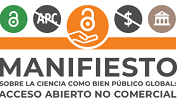
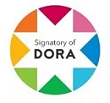
2.png)


